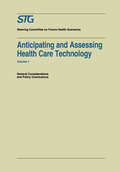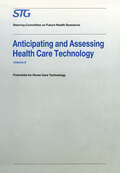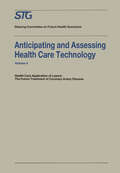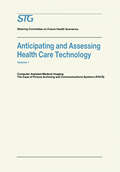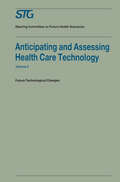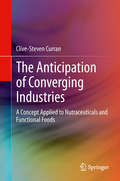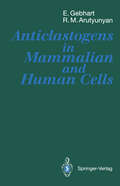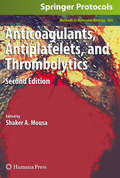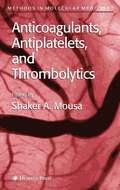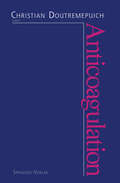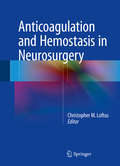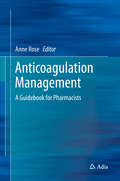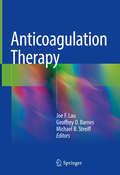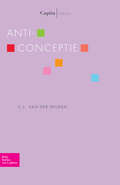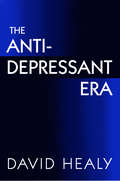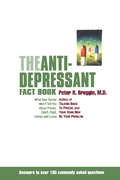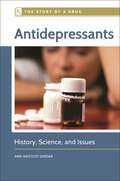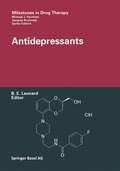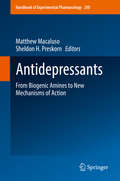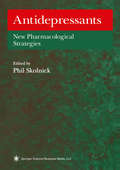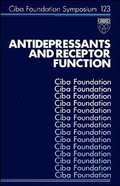- Table View
- List View
Anticarcinogenesis and Radiation Protection
by Peter CeruttiThis book is based on the invited and contributed papers presented at the 2nd International Conference on Anticarcinogenesis and Radiation Protection held at the National Bureau of Standards, Gaithersburg, Maryland, USA, on March 8-12, 1987. The conference documented developments that have taken place in areas that were addressed during the first conference in 1982. A number of new topics, such as biological response modifiers, were included because of their emerging relevance to anticarcinogenesis and radiation protection. The organization of the material in this book does not follow the conference program; rather, we have attempted to provide a different sequence for didactic reasons. The aim of the conference, which is reflected in this book, was to promote further development of mechanistic approaches to cancer prevention and treatment based on recent progress in molecular biology and free radical chemistry. At the basis of carcinogenesis lie changes in the dynamics of growth and differentiation of specific cell subpopulations in the target tissue. 'These changes are brought about by selective toxicity and modulation of gene expression that are induced by xenobiotic carcinogens and affected by physiological and genetic factors. The book deals with oxidative stress and molecular damage caused by radiation and chemical pro-oxidants and their role in carcinogenesis, and it discusses mechanisms of deregulation of the expression of oncogenes and other genes involved in carcinogenic initiation and promotion.
Anticarcinogenesis and Radiation Protection 2
by O. F. Nygaard A. C. UptonThe dramatic decrease in the incidence of stomach cancer in industrialized countries during the past 50 years, which is yet to be fully explained, and the observation that carcinogenesis in laboratory animals can be inhibited by antioxidants, retinoids, and caloric restriction, among other influences, challenge us to press on in the search for practical means to prevent cancer. It is in relation to this goal that the studies summarized in this book have special significance. This book is based on the invited and contributed papers presented at the Third Internationai Conference on Anticarcinogenesis and Radiation Protection, held on October 15-21, 1989, in Dubrovnik, Yugoslavia. They cover a broad range of investigations into the mechanisms and inhibition of carcinogenesis. In keeping with recent advances in our understanding of the importance of oncogenes and tumor-suppressor genes in carcinogenesis, many of the reports focus on mutations and related changes at the level of DNA. At the same time, however, other reports deal with nutritional, immunological, endocrinological, and epidemiological aspects. In all, the various reports address carcinogenesis and its inhibition at virtually every level of biological organization. Included in this compendium are timely reviews of diverse and promising research strategies for cancer prevention, as pursued by investigators in different parts of the world. The Organizers of the Conference are grateful to the many scientists who have contributed to the volume, as well as to the sponsors of the Conference, without whose generous support this book would not have been possible.
Anticipating and Assessing Health Care Technology: General Considerations and Policy Conclusions. A report commissioned by the Steering Committee on Future Health Scenarios (Future Health Scenarios)
by H. David BantaThis report, Anticipating and Assessing Health Care Technology, is the first report from the STG Commission on Future Health Care Technology. The STG (Stuurgroep Toekomstscenario's Gezondheidzorg) was established in 1983 as an independent advisory group to the State Secretary for Welfare, Public Health, and Cultural Affairs (WVC) to assist in long-range health planning efforts. Thus far, STG commissions have examined cardiovascular disease, cancer, aging, and life styles as issues of importance to the health of the Dutch population in the future. Obviously, health care technology is of great concern to the government. On the one hand, technology is one of the major tools to promote a healthy population. On the other hand, the costs of health care have been rising at an alarming rate in recent years. It was these two facts, along with the social consequences of certain technologies such as genetic screening, that led the STG to establish the Commission on Future Health Care Technology in 1985. The European Office of the World Health Organization (EURO) cosponsored the project. The Health Council (Gezondheidsraad) agreed to cooperate with the project by furnishing space and intellectual and logistical support. The goal of the Commission's work is to develop sufficient information on future technological developments in health and health care to assist planning for their consequences. Subsequent reports will give more detail on future health care technologies and will provide in-depth assessments on a few specific technological areas.
Anticipating and Assessing Health Care Technology: Potentials for Home Care Technology (Future Health Scenarios)
by Scenario Commission on Future Health Care TechnologyAs noted in the Foreword, this report is one of several volumes resulting from this study of future health care technology. The purpose of the study, as formulated by the STG, was to analyze future health care technology. Part of the task was to develop an 'early warning system' for health care technology. The primary goal of the project was to develop a list or description of a number of possible and probable future health care technologies, as well as information on their importance. Within the limits of time and money, this has been done. However, given the vast number of possible future health care technologies, complete information on the importance of each area could not be developed in any depth for all technology. Therefore, four specific technologies were chosen and were prospectively assessed. These future technologies were examined in more depth, looking particularly at their future health and policy implications. Subsequently, the project was extended to September 1987, and two additional technologies were chosen for assessment.
Anticipating and Assessing Health Care Technology: Health Care Application of Lasers: The Future Treatment of Coronary Artery Disease. A report, commissioned by the Steering Committee on Future Health Scenarios (Future Health Scenarios)
by Scenario Commission on Future Health Care TechnologyAs noted in the Foreword, this report is one of several volumes resulting from this study of future health care technology. The purpose of the study, as formulated by the STG, was to analyze future health care technology. Part of the task was to develop an 'early warning system' for health care technology. The primary goal of the project was to develop a list or description of a number of possible and probable future health care technologies, as well as information on their importance. Within the limits of time and money, this has been done. However, given the vast number of possible future health care technologies, complete information on the importance of each area could not be developed in any depth for all technology. Therefore, four specific technologies were chosen and were prospectively assessed. These future technologies were examined in more depth, looking particularly at their future health and policy implications. Subsequently, the project was extended to September 1986, and two additional technologies will be assessed.
Anticipating and Assessing Health Care Technology: Computer Assisted Medical Imaging. The Case of Picture Archiving and Communications Systems (PACS). (Future Health Scenarios)
by Scenario Commission on Future Health Care TechnologyAs noted in the Foreword, this report is one of several volumes resulting from this study of future health care technology. The purpose of the study, as formulated by the STG, was to analyze future health care technology. Part of the task was to develop an 'early warning system' for health care technology. The primary goal of the project was to develop a list or description of a number of possible and probable future health care technologies, as well as information on their importance. Within the limits of time and money, this has been done. However, given the vast number of possible future health care technologies, complete information on the importance of each area could not be developed in any depth for all technology. Therefore, four specific technologies were chosen and were prospectively assessed. These future technologies were examined in more depth, looking particularly at their future health and policy implications. Subsequently, the project was extended to September 1986, and two additional technologies were chosen for assessment.
Anticipating and Assessing Health Care Technology, Volume 2: Future technological changes. A report commissioned by the Steering Committee on Future Health Scenarios (Future Health Scenarios)
by H. David BantaAs noted in the Foreword, this report is the second of several volumes resulting from this study of future health care technology. The purpose of the study, as formulated by the STG, was to analyze future health care technology. Part of the task was to develop an 'early warning system' for health care technology. The primary goal of the project was to develop a list or description of a number of possible and probable future health care technologies, as well as information on their importance. Within the limits of time and money, this has been done. This report is the description of anticipated future health care technologies. However, given the vast number of possible future health care technologies, complete information on the importance of each area could not be developed in any depth for all technology. Therefore, four specific technologies were chosen and were prospectively assessed. These future technologies were examined in more depth, looking particularly at their future health and policy implications. Subsequently, the project was extended to September 1987, and two additional technologies are being assessed.
The Anticipation of Converging Industries: A Concept Applied to Nutraceuticals and Functional Foods
by Clive-Steven CurranThe blurring of boundaries between hitherto distinct scientific disciplines, technologies or markets is a common and powerful phenomenon. Subjects of this convergence often change consumer behaviours, favouring products and platforms with multiple functions. The Anticipation of Converging Industries provides a detailed focus on the triggers, drivers and consequences of convergence to create a more concise definition of convergence. This detailed analysis includes a specifically developed toolbox for ‘convergence foresight’, creating a forecasting method for convergence trends. With the focus on the chemical, biotechnological and pharmaceutical industries, several indicators of convergence in the areas of Nutraceuticals/Functional Foods, Cosmeceuticals and ICT are derived from samples including over 1million patents and scientific publications. By supporting this methodical approach with real world data, The Anticipation of Converging Industries is perfect for industry practitioners looking for a competitive edge in the present and for the future. Similarly, academics will find a comprehensive theoretical concept for better understanding the underlying rationale of convergence at their disposal
Anticlastogens in Mammalian and Human Cells
by Erich Gebhart Ruben M. ArutyunyanAnticlastogens in Mammalian and Human Cells covers research on the protection of chromosomes from the action of chemical mutagens by use of natural and synthetic antimutagens, which, because of their specific action on clastogenic damage are called anticlastogens. Based on an introductory chapter on nature and mode of formation of chromosome aberrations induced by chemical and also physical mutagens, the action of anticlastogens is discussed in detail. A definition and delineation of the term anticlastogenesis is followed by considerations on the various possibilities of classifying anticlastogens. Attention is paid to the action of anticlastogens in mammalian and human cell culture systems, in vivo data on anticlastogens are presented in great detail, as are the actions of anticlastogens on induced sister chromatid exchanges in various test systems. A mainly historical side-glance at the action of anticlastogens on chromosome damage induced by ionizing radiation is taken. The practical consequences of the findings on anticlastogenic action are extensively discussed as aspects of further research.
Anticoagulants, Antiplatelets, and Thrombolytics: Methods And Protocols (Methods in Molecular Biology #663)
by Shaker A. MousaDuring the past decade, remarkable progress has been made in the development of newer drugs to prevent and treat thromboembolic disorders, such as oral direct anti-Xa and anti-IIa antagonists, as well as oral antiplatelet ADP antagonists with rapid onset and offset. In addition, there has been concentrated effort aimed at identifying novel uses of traditional antithrombotic drugs, such as aspirin, heparin, and oral anticoagulants, as well as combinations of agents, such as more than one antiplatelet, antiplatelet with anticoagulant, antiplatelet with or without thrombolytic. Anticoagulants, Antiplatelets, and Thrombolytics, Second Edition provides updates on various strategies in thrombosis, experimental models, and clinical and recent advances in the discovery and development of novel antithrombotics. As a volume in the highly successful Methods in Molecular Biology™ series, this collection provides the kind of detailed description and implementation advice that is crucial for getting optimal results. Easy to use and up to date, Anticoagulants, Antiplatelets, and Thrombolytics, Second Edition is an ideal guide for researchers aiming for the future of this vital field, focusing on the prevention of thromboembolic disorders and the protection of the vascular endothelium.
Anticoagulants, Antiplatelets, and Thrombolytics: Methods And Protocols (Methods in Molecular Medicine #93)
by Shaker A. MousaAnticoagulation
by Christian DoutremepuichAll medical specialists who must contend with the possibility of thrombosis will be interested in Anticoagulation. This book evaluates anticoagulation procedures from various points of view - from Current Trends in Anti-thrombotic Drugs, to Treatment of Ischemic Vascular Disorders; from Anticoagulants in Pregnancy, to Anticoagulation in the Elderly, from the Effects of Anticoagulant Therapy on the Heart, to Anticoagulation in various Surgical Procedures. Anticoagulation is a resource of approaches to the management of this common medical problem.
Anticoagulation and Hemostasis in Neurosurgery
by Christopher M. LoftusThis book is an up-to-date reference on all aspects of anticoagulation and hemostasis in neurosurgery. After an opening section on basic principles and drug classes in current use, detailed consideration is given to coagulation issues relevant to all patients, not just neurosurgical ones. The coverage includes, for example, deep vein thrombosis, pulmonary embolism, and disseminated intravascular coagulation. A variety of important issues specific to neurosurgical practice are then addressed, and a summary of current guidelines and best practices is provided. By bringing together the latest knowledge from across the discipline, this book will serve as a sound basis for informed decision making in surgical practice. It will be of daily value for neurosurgeons and trainees worldwide and will also be of interest to emergency room physicians, surgeons in general, critical care physicians, neurologists, and hospital medicine specialists.
Anticoagulation Management: A Guidebook for Pharmacists
by Anne RoseIn addition to acting as a training guide for pharmacists, pharmacy residents and pharmacy students who seek to practice in areas associated with patients on anticoagulant therapy, the information presented within highlights the growing role of the pharmacist in these contexts. Readers will find useful information on anticoagulant management across all pharmacy practice areas, including the inpatient, ambulatory, emergency services and transitions of care settings. Particular attention is given to summarizing best practices and providing ‘real world’ examples of ways in which pharmacists can be involved in anticoagulation management and the impact of such involvement. In the first major section of the book, each chapter focuses on the role of the pharmacist in the management of medication with a specific type of anticoagulants (e.g. warfarin, heparin and target-specific oral agents) in various healthcare settings. A broader overview of the clinical management of anticoagulation therapy is provided in the second major section, including descriptions of the role of pharmacists in assessing venous thromboembolism risk, ensuring patients receive appropriate prophylactic therapy, and monitoring outcomes.
Anticoagulation Therapy
by Joe F. Lau Geoffrey D. Barnes Michael B. StreiffThis book presents the latest evidence and guidelines supporting the use of anticoagulant therapy for various clinical scenarios. The field of anticoagulation therapy is evolving rapidly, particularly since the arrival and widespread adoption of direct oral anticoagulants. Organized in two parts, this book reviews the pharmacologic properties of various anticoagulants and details the clinical applications of anticoagulant therapy. Drugs such as warfarin and unfractionated heparin, as well as parenteral and direct oral anticoagulants are discussed in terms of their pharmacokinetics, drug-disease interactions, dosing strategies, and risk considerations. Clinical applications of anticoagulant therapy in disorders such as acute coronary syndromes, atrial fibrillation, and thrombophilia and in special populations such as pregnant women, the elderly, and in the patient with cancer are highlighted. Clinical vignettes, algorithms, clinical pearls, and self-assessment questions are integrated throughout the book. Featuring contributions from authorities in the field, Anticoagulation Therapy is an essential resource for cardiologists, vascular medicine specialists, hematologists, internists, and all other healthcare professionals who prescribe anticoagulants.
Anticonceptie: Capita Selecta
by Carla Van Der WijdenHet deel Anticonceptie van de reeks Capita Selecta gaat in op thema's als HPV-vaccinatie, op latere leeftijd zwanger worden en de weerslag van ziekte en ouderdom op intimiteit en seksualiteit bij de steeds ouder wordende vrouw en man. De bijdragen zijn afkomstig uit de professionele vakliteratuur en geselecteerd door een expert op het terrein van de anticonceptie. Op die manier is gegarandeerd dat het thema op een gevarieerde en verrassende wijze wordt belicht.
The Antidepressant Era (PDF)
by David HealyWhen we stop at the pharmacy to pick up our Prozac, are we simply buying a drug? Or are we buying into a disease as well? An account of the phenomenon of antidepressants, this book relates how depression, a disease only recently deemed too rare to merit study, has become one of the most common disorders of our day and a booming business to boot.;This book chronicles the history of psychopharmacology from its inception with the discovery of chlorpromazine in 1951 to current battles over whether these powerful chemical compounds should replace psychotherapy. An expert in both the history and the science of neurochemistry and psychopharmacology, David Healy offers a close-up perspective on early research and clinical trials, the stumbling and successes that have made Prozac and Zoloft household names. The complex story he tells, against a backdrop of changing ideas about medicine, details the origins of the pharmaceutical industry, the pressures for regulation of drug companies, and the emergence of the idea of a depressive disease. This historical and neurochemical analysis leads to a clear look at what antidepressants reveal about both the workings of the brain and the sociology of drug marketing.;Most arresting is Healy's insight into the marketing of antidepressants and the medicalization of the neuroses. Demonstrating that pharmaceutical companies are as much in the business of selling psychiatric diagnoses as of selling psychotropic drugs, he raises disturbing questions about how much of medical science is governed by financial interest.
The Antidepressant Fact Book: What Your Doctor Won't Tell You About Prozac, Zoloft, Paxil, Celexa, And Luvox
by Peter BregginKnown as "the Ralph Nader of psychiatry," Dr. Peter Breggin has been the medical expert in countless court cases involving the use or misuse of psychoactive medications. This unusual position has given him unprecedented access to private pharmaceutical research and correspondence files, information from which informs this straight-talking guide to the most prescribed and controversial category of American drugs: antidepressants. From how these drugs work in the brain to how they treat (or don't treat) depression and obsessive-compulsive, panic, and other disorders; from the documented side and withdrawal effects to what every parent needs to know about antidepressants and teenagers, The Anti-Depressant Fact Book is up-to-the minute and easy-to-access. Hard-hitting and enlightening, every current, former, and prospective antidepressant-user will want to read this book.
The Antidepressant Fact Book: What Your Doctor Won't Tell You About Prozac, Zoloft, Paxil, Celexa, And Luvox
by Peter BregginKnown as "the Ralph Nader of psychiatry," Dr. Peter Breggin has been the medical expert in countless court cases involving the use or misuse of psychoactive medications. This unusual position has given him unprecedented access to private pharmaceutical research and correspondence files, information from which informs this straight-talking guide to the most prescribed and controversial category of American drugs: antidepressants. From how these drugs work in the brain to how they treat (or don't treat) depression and obsessive-compulsive, panic, and other disorders; from the documented side and withdrawal effects to what every parent needs to know about antidepressants and teenagers, The Anti-Depressant Fact Book is up-to-the minute and easy-to-access. Hard-hitting and enlightening, every current, former, and prospective antidepressant-user will want to read this book.
Antidepressants: History, Science, and Issues (The Story of a Drug)
by Ann Westcot JordanThis accessible volume offers a holistic exploration of this diverse class of drugs, from medical, historical, cultural, and economic perspectives.Depression is one of the most commonly reported mental disorders, and it affects millions of Americans. A wide variety of medications are used to treat depression, many of which have become household names—Zoloft, Prozac, and Paxil among them. Because these medications have the ability to alter how people think and feel, however, physicians must weigh a number of factors when prescribing them, especially to teens. Antidepressants: History, Science, and Issues, a part of Greenwood's Story of a Drug series, offers a robust exploration of antidepressant medications that covers the historical, ethical, medical, legal, and scientific dimensions of these drugs.After an introductory case study of a person with depression and this individual's problems and successes with antidepressants, the book provides an overview of depression and its various symptoms as well as the causes, prevalence, and diagnosis of depression. Readers will gain an understanding of the neurotransmission and specific mechanisms behind the activity of antidepressant medications; the effects and applications of these drugs, plus their associated risks of misuse and abuse; and related policy and societal issues.
Antidepressants: History, Science, and Issues (The Story of a Drug)
by Ann Westcot JordanThis accessible volume offers a holistic exploration of this diverse class of drugs, from medical, historical, cultural, and economic perspectives.Depression is one of the most commonly reported mental disorders, and it affects millions of Americans. A wide variety of medications are used to treat depression, many of which have become household names—Zoloft, Prozac, and Paxil among them. Because these medications have the ability to alter how people think and feel, however, physicians must weigh a number of factors when prescribing them, especially to teens. Antidepressants: History, Science, and Issues, a part of Greenwood's Story of a Drug series, offers a robust exploration of antidepressant medications that covers the historical, ethical, medical, legal, and scientific dimensions of these drugs.After an introductory case study of a person with depression and this individual's problems and successes with antidepressants, the book provides an overview of depression and its various symptoms as well as the causes, prevalence, and diagnosis of depression. Readers will gain an understanding of the neurotransmission and specific mechanisms behind the activity of antidepressant medications; the effects and applications of these drugs, plus their associated risks of misuse and abuse; and related policy and societal issues.
Antidepressants (Milestones in Drug Therapy)
by Brian E. LeonardImportant clinical issues as the outcome of long term treatment with antidepressants, the time of onset of the antidepressant response and the limitations of the antidepressants currently available are covered in this monograph. Leading researchers in the area of clinical and experimental psychopharmacology critically assess the progress in their specialist fields. The mechanisms of action of antidepressants are considered, followed by clinical research into the role of the hypothalamic-pituitary-adrenal axis and the immune system in the biology of depression and in response to treatment. The final chapter deals with the important chemical entities now undergoing development as antidepressants. The purpose of this monograph is not only to inform but also to stimulate research into the biology of depression and the mechanisms behind the action of effective antidepressants. This monograph is of interest to psychiatrists, psychologists, pharmacologists, neuroscientists and endocrinologists.
Antidepressants: From Biogenic Amine To New Mechanisms Of Action (Handbook of Experimental Pharmacology #250)
by Matthew Macaluso Sheldon H. PreskornThis volume reviews the known neurobiology of depression and combines classic data on antidepressant treatments with modern theory on the physiology of depression. It also discusses novel mechanism of action drugs.
Antidepressants: New Pharmacological Strategies (Contemporary Neuroscience)
by Phil SkolnickIn this book, leading-edge investigators offer effective strategies to improve current antidepressive therapies and suggest molecular, biological, and genetic approaches that will lead to the development of novel antidepressants. The contributors' critical reviews and commentaries illuminate our understanding of the mechanism(s) responsible for antidepressant action. The book's goal is to move beyond current biogenic amine-based concepts and therapies to the development of new and improved antidepressants that are more effective and have a more rapid onset than current.
Antidepressants and Receptor Function (Novartis Foundation Symposia #123)
by Gregory R. Bock Sarah Clark Ruth PorterCiba Foundation Symposium 123 Antidepressants and Receptor FunctionChairman: Dennis Murphy, 1986 Depression is a common and often debilitating affective disorder. Attempts to develop effective antidepressants have a long history, but many questions remain about the mechanisms of action of such treatments and about the aetiology and pathophysiology of depression itself. Early observations centred attention on central monoamine systems, and animal studies suggested that changes in beta-adrenoceptor responsiveness were a common effect of antidepressant therapies. More recent research has encompassed many different central and peripheral receptors, time-dependent adaptational events at synapses, and the functional significance of changes in neurotransmitter systems in both humans and experimental animals. Such pharmacological studies aimed ultimately at elucidating the neurochemical basis of depression and of promoting new therapeutic approaches, provide the focus of this symposium volume. Many different methods of investigating the links between monoamine systems, depression and antidepressant treatments are described. Recent studies of receptors and of monoamine uptake sites in the brain and the periphery (e.g. in platelets and fibroblasts) are reviewed, with emphasis on alpha and beta adrenoceptors, [3H]imipramine-binding sites and serotonin receptors. The results of monitoring amine metabolites in cerebrospinal fluid and of measuring neuroendocrine, physiological and behavioural responses to pharmacological challenge are presented, providing information on monoaminergic function in depressed patients and experimental animals before, during and after treatment with antidepressant drugs or electroconvulsive shock. Genetic influences on receptor density are also discussed, as is the relevance to human depressive illness of animal models, including stress-induced behavioural depression in rats and responses to social stressors in rhesus monkeys. This book should be of interest to neuropharmacologists, psychopharmacologists, clinical pharmacologists, behavioural scientists, psychiatrists and neuroscientists.


